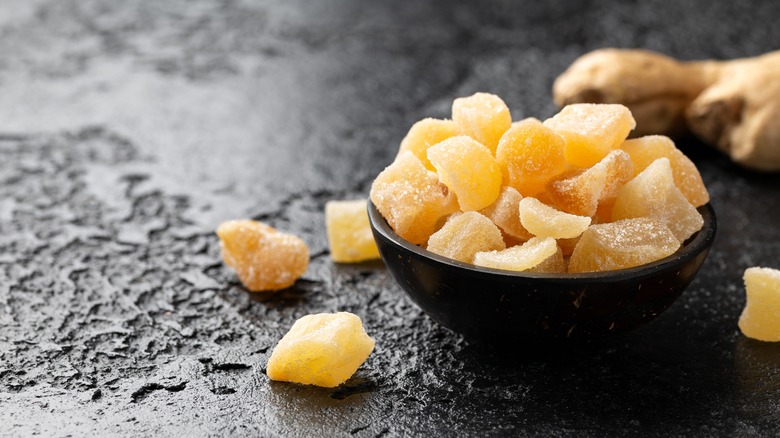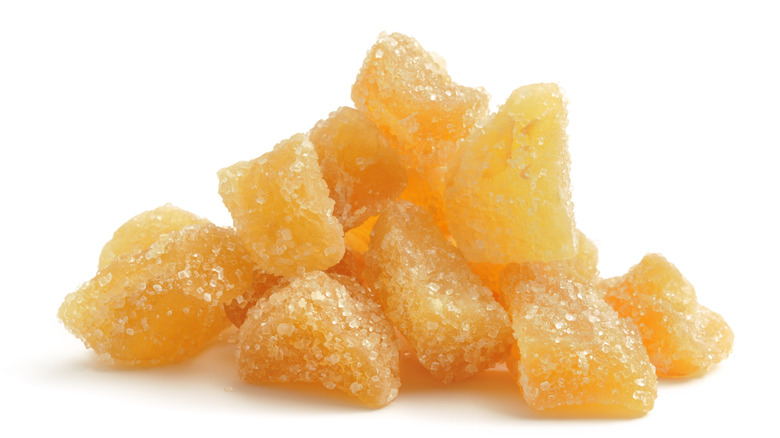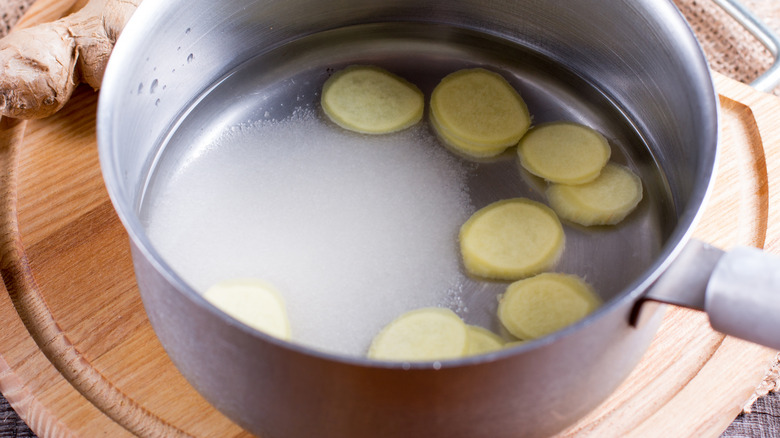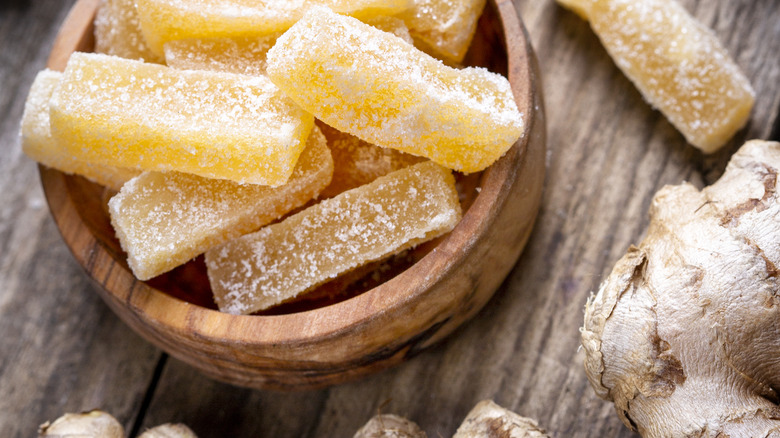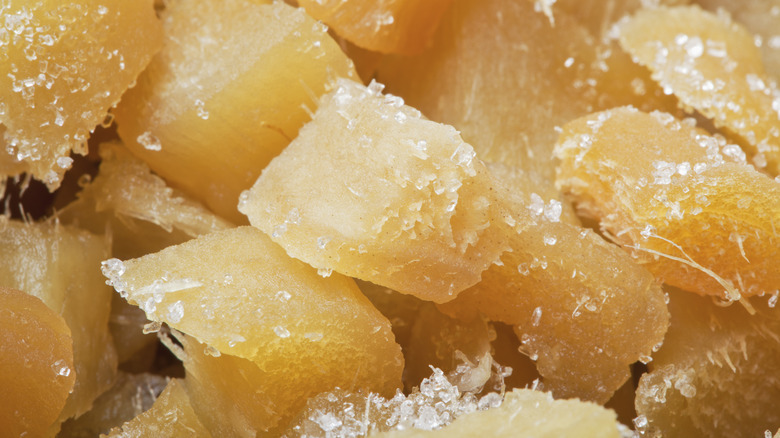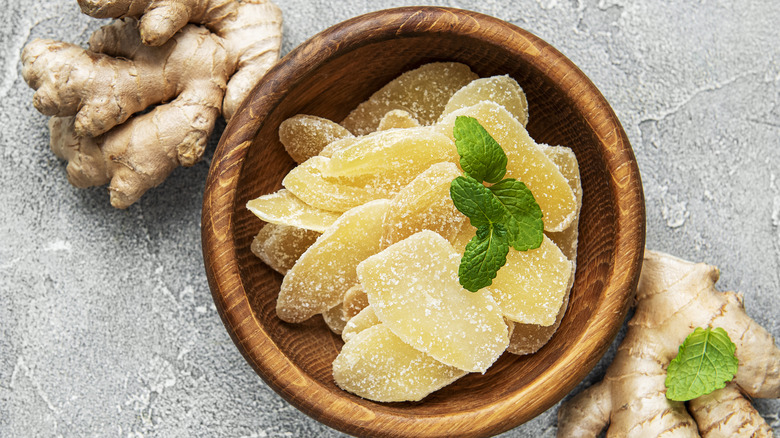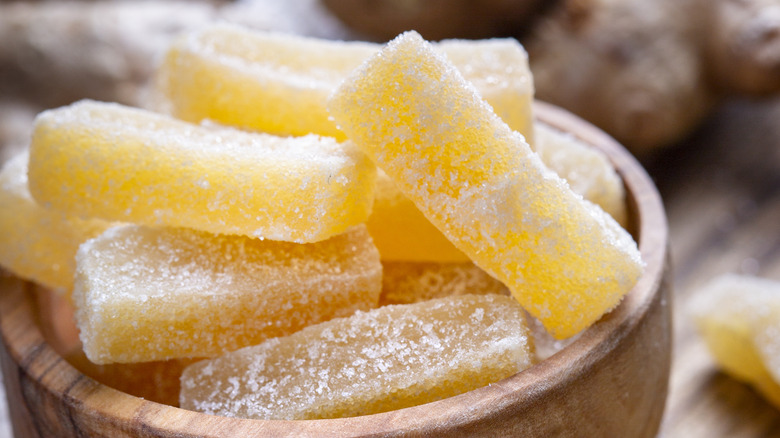Crystallized Ginger Gives A Unique Kick To Baked Goods And More
Ginger's has been beloved by humans for centuries — research suggests it's been in use for 5,000 years. Not only does its earthy spicy flavor add complexity to dishes, but it's backed by a medley of health benefits, too. From its origins in India and China, the root expanded throughout Eurasia. By the Middle Ages, it was already undergoing preservation methods for export to Europe.
So, while fresh ginger has a storied — and dependable — place in the kitchen, processed versions are worth your while, too. For a version of the root with a sweet twist, turn to crystallized ginger. Made by infusing chunks of the root with syrup, then rolling in sugar, and drying, the food is tasty and shelf-stable. It's easy to enjoy on its own or to integrate into a medley of sweet or savory applications. Whether store-bought or made in the home, a batch won't last long. Let's dive into the details.
What is crystallized ginger?
Although less pungent than fresh ginger, the crystallized root still has a bold character. Equal parts sweet and spicy, its chewy consistency delivers a strong dose of ginger flavor. With increased shelf-stability due to sugar, many confuse it with candied or stem ginger. It undergoes a similar creation process to candied ginger, with boiling, followed by an infusion in sugar syrup. However, crystallized ginger is then covered with more sugar on the exterior and dried. Stem ginger — which is especially popular in the U.K. — also undergoes infusion in syrup. This root variant remains in the liquid, which lends it a softer consistency.
Crystallized ginger's dried state lends it durability and ease of transport, distinguishing it from other varieties. Its chewy texture becomes prominent in a dish, making it an ideal topping or mixed-in component. And the added sugar takes off some of its bite, enough to be enjoyed as a snack on its own.
How is crystallized ginger made?
As per its name, crystallized ginger utilizes sugar to achieve a candied texture. However, to create such an encrusted result with a soft interior, the root first needs to be cleaned, chopped, and cooked. The process starts by peeling the ginger — preferably underripe– taking care to eliminate all morsels of skin. Next, the plant is roughly chopped, creating morsels larger than the desired result, as they'll shrink during preparation. The chunks are boiled in a large volume of water for up to thirty minutes, with any foam skimmed off during the process.
Finally, it's time for the candying process. The ginger is added to a pot with equal parts water and white sugar. The mixture is simmered until the ginger is soft, chewy, and infused with sweet syrup. It's then tossed in sugar and allowed to air dry, with some accelerating the process in the oven. Once completed, the ginger shrinks in size and boasts a beautiful brown color. It's vital to place it in a sterilized jar to ensure shelf-life.
Fresh vs. crystallized ginger
Crystallized ginger's preparation process makes it distinct from fresh and powdered varieties. For starters, its heating process, combined with its sugary application, makes it an enjoyable snack on its own, while raw ginger is less palatable straight. The cooking process lessens ginger's starchier qualities and evaporates some of the essential oils, which lend the raw root pungency. As a result, a ground spice version of the plant supplemented with sugar is a closer substitute to crystallized ginger than the raw root.
Especially due to its sugary consistency, crystallized ginger is not interchangeable with the raw root. The crystallized root's sweeter, less vibrant flavor won't meld into dishes in the same manner — for example, it won't add earthy freshness to a curry or soup. The texture poses issues, too; its stickiness makes it difficult to pulverize with other ingredients. So, although processed with only sugar, it's best to keep the ginger varieties separate.
How to cook with crystallized ginger?
From toffee bars and muffins to gingersnaps, crystallized ginger is frequently employed in baking applications. Its gentle heat and sugary texture make it an accessible way to add a dash of flavor. It can be used as a topping on everything from cupcakes and cakes to cocktails or chopped and mixed into batter. Savvy bakers can even integrate it into crusts, adding a warm, earthy note to a tart.
The easily stored food also functions well in quickly made treats. Throw crystallized ginger into granola bars, yogurt bowls, or even atop ice cream for a dash of spicy-sweet heat. Or dip it into chocolate to form a dessert of its own. And it's malleability also makes it a tasty component in savory dishes, too. Combine it with rice, and roasted vegetables, or integrate it into stir-fries and salads. Just remember, less is more; too much will overpower a dish with gingery flavor.
Where to buy crystallized ginger
Crystallized ginger is easy to find at groceries — with brands like Trader Joe's and Target carrying their own varieties. The sugar-encrusted root is also readily sold online, or it's not difficult to make at home — it simply involves some prep work and patience.
Crystallized ginger is durable and will last up to two to three years in a dark, cool location. In fact, factory-made renditions of the food don't spoil at all and instead simply lose their potency. So, to retain its flavor, store it in an air-tight container and smell it for freshness before use.
If dealing with homemade crystallized ginger, keep in mind the external layer of sugar is what keeps the food shelf-stable, so coat well when crafting the treat. To lengthen its shelf-life, store it in the fridge, which will double the duration it's edible. However, chances are, such a move won't be necessary. The preserve's pleasant kick is seldom unwanted.
Nutrition of crystallized ginger
Ginger's health benefits have been esteemed for centuries — the root offers loads of nutritional value. When crystallized, it offers a more palatable method of ingestion. The root is especially handy against nausea, vomiting, and stomachaches, which makes it a handy substance during travels, notes Live Strong. Plus, its contained compounds like gingerols, paradols, shogaol have been shown to have anti-inflammatory and antioxidant properties. A 30-gram serving of crystallized ginger also contains 4% of daily Calcium intake — an element necessary for bone, cardiovascular, and muscle health, according to Medical News Today.
However, crystallized ginger does come with the adverse effects of sugar consumption. It contains far more calories and carbohydrates than the raw version — a single serving of the crystallized root is close to a daily serving of sugar, per Live Strong. As a result, it's best to enjoy it in moderation. With its delicious, bold flavor, a small amount of crystallized ginger goes a long way.
